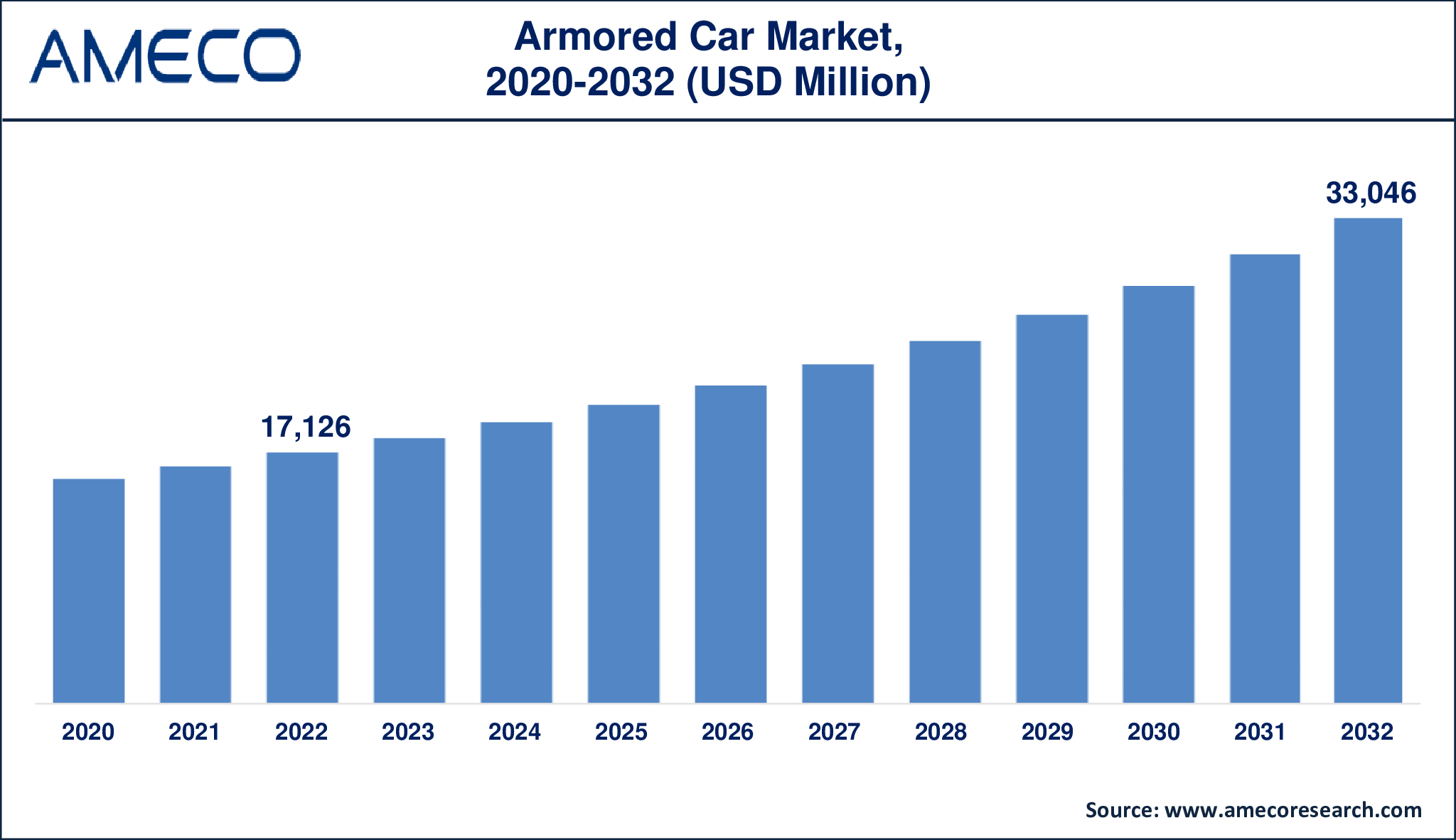Armored Car Market Growth Opportunities and Forecast till 2032
The Global Armored Car Market Size was valued at USD 17,126 Million in 2022 and is anticipated to reach USD 33,046 Million by 2032 with a CAGR of 6.9% from 2023 to 2032.
An armored car, also known as an armored vehicle, is a specialized type of vehicle that is designed and manufactured to offer people and cargo with a high level of protection. These vehicles have a variety of security systems and armored components to protect against a variety of dangers, such as ballistic attacks, explosives, and physical assaults.

The primary function of armored vehicles is to protect humans, precious assets, and sensitive commodities during transit. They are routinely employed to solve security problems in a range of sectors and businesses, and their uses can vary greatly.
Armored cars are used in the banking sector to transfer cash, coins, and other important items in a secure manner. To guard against theft and threats, these cash-in-transit (CIT) trucks include reinforced body constructions, bullet-resistant glass, and safe compartments.
|
Parameter |
Armored Car Market |
|
Armored Car Market Size in 2022 |
US$ 17,126 Million |
|
Armored Car Market Forecast By 2032 |
US$ 33,046 Million |
|
Armored Car Market CAGR During 2023 – 2032 |
6.9% |
|
Armored Car Market Analysis Period |
2020 - 2032 |
|
Armored Car Market Base Year |
2022 |
|
Armored Car Market Forecast Data |
2023 - 2032 |
|
Segments Covered |
By Type, By Ownership, By End-User, By Application, and By Region |
|
Armored Car Market Regional Scope |
North America, Europe, Asia Pacific, Latin America, and Middle East & Africa |
|
Key Companies Profiled |
BAE Systems, Bullrich, Ford Motor Company, General Dynamics Land Systems, INKAS Group of Companies, Iveco Defence Vehicles, Lenco Armored Vehicles, MSPV (Military and Security Vehicle), Oshkosh Defense, and Streit Group. |
|
Report Coverage |
Market Trends, Drivers, Restraints, Competitive Analysis, Player Profiling, Regulation Analysis |
Armored Car Market Dynamics
Armored cars are used in the corporate sector to provide executive security and safe transportation for high-profile persons such as company leaders, government officials, and celebrities. These cars frequently have discrete, luxurious interiors while providing optimum security. Armored vehicles are used by the government and law enforcement organizations for tactical operations, crowd control, and border security. These specialized vehicles are built to endure harsh conditions and may contain features such as firing ports and communication systems.
Armored vehicles in the military include a wide range of kinds, including main battle tanks, armored personnel carriers (APCs), and infantry fighting vehicles (IFVs). These military-grade armored vehicles are intended for warfare and troop transport, and they provide protection from enemy fire on the battlefield. While the phrase "armored car" usually refers to wheeled vehicles, the business also encompasses tracked armored vehicles, such as tanks and armored reconnaissance vehicles, which are typically used for military purposes.
In essence, an armored automobile is a vehicle designed expressly to provide increased security and protection against numerous dangers. Its design and characteristics are determined by its intended application, which ranges from civilian security and transit to military combat and defense. The commitment of all armored vehicles to guaranteeing the safety and security of its personnel and cargo in potentially hazardous areas is their common thread.
Armored Car Market Segmentation
The armored car market is segmented by type, ownership, end-user, and geography. The type category is further subdivided into cash-in-transit (CIT) vehicles, armored personnel carriers (APCs), armored SUVs, armored sedans, and others. Financial institutions, government and law enforcement, corporate, VIPs and celebrities, military, and others are the categorization of end-user. Government-owned and private-owned are the ownership types. The region sector includes North America, Asia-Pacific, Europe, Latin America, the Middle East, and Africa.
Global Armored Car Market Geographical Competition
The United States is a prominent market for armored vehicles in North America. Security concerns, the necessity for safe financial logistics, and the need for executive protection are driving demand. Armored cars are often used by financial organizations, security firms, and private persons. Similarly, Canada is a developing market, with a special emphasis on cash-in-transit (CIT) services and VIP security.
Western and Eastern Europe have different outlooks. Western European countries, such as the United Kingdom, Germany, and France, have sizable markets for armored vehicles, with a focus on VIP security and safe transit. Eastern European countries, on the other hand, have a higher need for military armored vehicles used for law enforcement and defense.
The armored car market in Asia-Pacific countries has grown significantly. China's economic boom has resulted in an increase in demand for armored SUVs, particularly among corporate clients and VIPs. The heightened security concerns and demand for CIT services are driving India's expanding industry. Middle Eastern countries, such as Saudi Arabia and the United Arab Emirates, have exhibited strong demand for armored vehicles, with a particular emphasis on VIP transit and government protection.
Global Armored Car Industry Segment Analysis
Market By Type
· Armored SUVs
· Armored Sedans
· Cash-in-Transit (CIT) Vehicles
· Armored Personnel Carriers (APCs)
· Others
Market By Ownership
· Private-Owned
· Government-Owned
Market By End-User
· Government and Law Enforcement
· Financial Institutions
· Corporate
· VIPs and Celebrities
· Military
· Others
Armored Car Market Leading Companies
The players profiled in the report are BAE Systems, Bullrich, Ford Motor Company, General Dynamics Land Systems, INKAS Group of Companies, Iveco Defence Vehicles, Lenco Armored Vehicles, MSPV (Military and Security Vehicle), Oshkosh Defense, and Streit Group.
Armored Car Market Regions
North America
· U.S.
· Canada
Europe
· U.K.
· Germany
· France
· Spain
· Rest of Europe
Latin America
· Brazil
· Mexico
· Rest of Latin America
Asia-Pacific
· China
· Japan
· India
· Australia
· South Korea
· Rest of Asia-Pacific
Middle East & Africa
· GCC
· South Africa
· Rest of Middle East & Africa